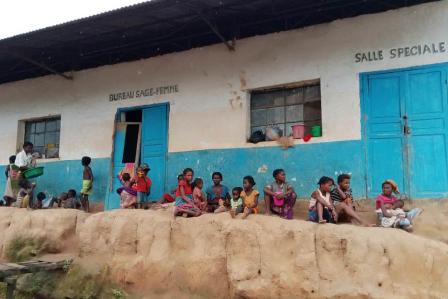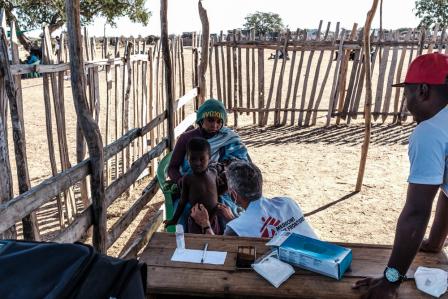Famine crisis looms in southern Madagascar

People in the southeast of Madagascar are facing the most acute nutritional and food crisis the region has seen in recent years. Doctors Without Borders began setting up mobile clinics in Amboasary district in late March to screen and treat acute malnutrition in remote villages like those of Ranobe commune, providing ready-to-use therapeutic food and medical care.@iAko M. Randrianarivelo
An immediate and massive increase in food aid is urgently needed for people in southern Madagascar, says international medical organisation Doctors Without Borders/ Médecins Sans Frontières(MSF), whose teams in the region are witnessing an exceptionally severe malnutrition crisis which in some places borders on famine.
“We’re seeing totally destitute people who have literally nothing to eat and are teetering on the edge of survival,” says Julie Reversé, Doctors Without Borders operations coordinator in Madagascar. “Some have had to sell their cooking utensils and don’t even have containers to fetch water.”
In some villages in Amboasary district in Anôsy region, Doctors Wihtout Borders teams have found an average of 28 per cent of children under five are acutely malnourished, one-third of whom have severe malnutrition and are therefore at high risk of death.
“One alarming indicator is that the 2,200 people treated by Doctors Without Borders for acute malnutrition since the end of March include children under five, but also adolescents and adults,” says Reversé
A unique combination of factors has plunged southern Madagascar into this crisis. The worst drought in 30 years has wreaked havoc on agriculture; sandstorms caused by deforestation have covered much of the arable land in sand, even destroying food sources such as cactus fruit, normally eaten as a very last resort; and COVID-19 has had a spillover effect on the island's economy. Related to the ensuing food shortages are a reported rise in attacks, hold-ups and thefts of livestock, property and food.
Other factors include a surge in malaria infections and a lack of access to healthcare and drinking water, which have exacerbated the health situation still further.
Due to a lack of resources, food distributions by the World Food Programme (WFP) and other aid organisations are limited to half-day rations, while some affected villages are receiving no food aid at all. This is all the more worrying as access to food is likely to be an even bigger issue in the coming months, with little or no harvest expected in June and the onset of the lean season in October.
Getting aid to the people who need it is challenging. The island’s geography brings its own specific constraints and the semi-arid southern regions have many remote villages and few paved roads. It takes at least three days to drive from the capital Antananarivo to the main town in Amboasary district, and from there it can take many hours along tracks and trails to reach the most remote villages. In addition, in mid-March the authorities introduced restrictions on entering Madagascar and travelling within the country due to the COVID-19 pandemic.

42-year old Vitasoa has six children. She’s brought four of them to the Médecins Sans Frontières mobile clinic. All the children are included in the nutrition programme launched at the end of March to respond to the food and nutrition emergency in southern Madagascar.
“We live in Fenoarivo, and it took us five hours to walk here from Ranobe. During the rainy season, we live off cassava, mangoes and edible leaves. But, nothing’s growing because there’s been no rain. We make do with manioc tubers we find in the forest, cactus fruit and edible leaves. We have to dig in the sand for water as there’s also less surface water. Every day we pray for rain. We’re staying positive, but we really hope it’ll come soon.”
“Hundreds of thousands of people in southern Madagascar rely almost entirely on food aid,” says Bérengère Guais, Doctors Without Borders’ head of emergency operations. “A substantial effort – not only financial, but also logistical and human – is vital to ensure regular deliveries of food rations in sufficient quantities over a period of several months. Travel must be made easier for aid workers by ensuring regular flights to enter and move around the country. An entire population, spread across vast, remote areas with very little infrastructure, is in desperate need of life support. The clock is ticking.”
Since late March 2021, Doctors Without Borders teams have been screening and treating people for acute malnutrition and providing basic medical services through mobile clinics in Amboasary district. Doctors Without Borders teams are also working to improve people’s access to drinking water by distributing jerry cans, repairing hand-operated pumps and treating and transporting water drawn from the river. Doctors Without Borders teams are currently gearing up to launch food distributions and scale up inpatient treatment for patients with severe acute malnutrition and associated medical complications.
- “It’s hard to find the words to describe what I witnessed.”
In preparation for the rollout of Doctors Without Border’ medical activities, last month I went to around twenty villages in Amboasary district. It’s hard to find the words to describe what I witnessed. I was told about clouds, the rain that’s stopped falling, but even more about how in the past three years people’s lives have become one long descent into hell.
Three consecutive years of drought in the deserts of southern Madagascar have pushed people, who mostly live on agriculture and livestock production, to breaking point, and entire villages to the brink of death.
Village after village, it was the same story. No food left, dried-up rivers, nothing growing in the fields, stunted zebus, men lacking the strength to continue working, fear of looters who make off with the little that’s left. A few plots of land bordering a trickle of water showed signs of last attempts at cultivating, but the chances of a successful harvest are close to nil. If grasshoppers and caterpillars don’t get them first, the baking sun is there to finish the job of shrivelling the young shoots.
In three years, people here have lost everything. As their fields have dried up, they’ve sold their zebus, chickens, tools, and even kitchen utensils, to buy increasingly expensive food in markets it often takes them several hours to walk to from their homes. They mainly eat what they can forage – leaves, roots and barely edible fruit – and say they regularly fall sick because they’re poisonous. In the villages, children and adults are dying of hunger. Schools are empty, because the teachers have deserted them. No money is coming in, there’s no pay, and no food. All that’s left is insecurity, and the constant threat of gangs who steal anything they can get their hands on. More than one villager told me that, out of fear, they leave their homes at nightfall and sleep in small, nearby woods.
In the parched hills I saw young kids walking for hours, lugging sacks weighing up to 10 kilos. They were carrying food from the World Food Programme’s (WFP) distribution site to their villages where relatives, too weak to walk that far, were waiting for them. The risk of robbery along the way is considerable. Some kids prefer to sell for a paltry sum some of the goods too heavy for them to carry. WFP limits its rice, beans and oil distributions to half a ration per person, and not all villages have access. I struggle to understand how these people are able to survive.The sick, elderly and children were the only inhabitants in one of the villages I went to. All were in an appalling state. The rest of the villagers had gone, and those not strong enough to go with them had had to stay put. Small houses in surrounding hamlets are also deserted, so they just have to wait. They tell us that, since the rains stopped, they’ve had to sell their clothes and all they have left are shirts with more holes than fabric. Chickens, ducks, tools… looters steal anything that hasn’t been sold. They have nothing to wash themselves with, and for clean water, they have to make do with the river.
In almost thirty years of working in humanitarian aid, I have rarely witnessed such extreme hardship. A life-altering experience, it is situations like these that inspire me, time and time again, to assist people so often abandoned to their fate.
Food and nutrition crisis in Madagascar
Since the end of March, Doctors Without Borders teams have been responding to one of the worst food and nutrition crises ever experienced in southern Madagascar. Prior to deploying medical personnel, an exploratory team was sent to Amboasary district to conduct logistical and health assessments – actions essential to the rollout of an effective humanitarian response. One of the team was Jean Pletinck, an experienced logistician who has worked with Doctors Without Borders for 28 years.
Jean describes the catastrophic living conditions of people in remote regions of southern Madagascar.

